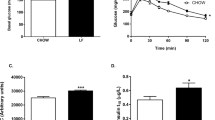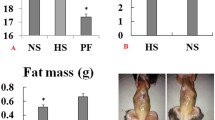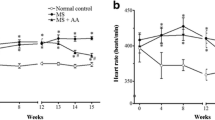Abstract
This study compared two established dietary formulations, high salt and high fat-high carbohydrate, separately or in combination on the induction cardiovascular dysfunction. One-month-old C57BL/6J mice were fed one of the following diets for 3 mo: (1) control diet consisting of a high fat-high simple carbohydrate (HFHSC); (2) 8% NaCl diet (HS); or (3) HFHSC diet supplemented with 1% NaCl (HFHS). After 3 mo, the HFHSC mice demonstrated significantly increased end-diastolic volume and end-systolic volume, specifically increases of 35% and 78%, respectively (p<0.01) and a reduction of ventricular stiffness by 27% (p=0.015). The HS mice exhibited arterial hypertension with an increase of 33% in maximum end-systolic pressure (p=.024) and a decrease of 44% in arterial elastance (p=0.020), corroborated by an increase in the heart weight to body weight ratios (p=0.002) and vascular types I and III collagen (p=0.03 and p=0.0008, respectively). The HFHS group revealed a striking response of 230% to the α1-adrenergic challenge (p=0.00034). These data suggest that the HFHSC diet causes dilaeed cardiomyopathy, whereas the HS diet produces arterial hypertension and the HFHS diet causes a vascular dysfunctional state that was highly responsive to α-adrenergic stimulation.
Similar content being viewed by others
References
Levy, D., Larson, M.G., Vasan, R.S., Kannel, W.B., and Ho, K.K. (1996). The progression from hypertension to congestive heart failure. JAMA 275:1557–1562.
Geleijnse, J.M., Kok, F.J., and Grobbee, D.E. (2003). Blood pressure response to changes in sodium and potassium intake: a metaregression analysis of randomised trials. J. Hum. Hypertens. 17:471–480.
Garrett, M.R., Dene, H., Walder, R., Zhang, Q.Y., Cicila, G.T., Assadnia, S., et al. (1998). Genome scan and congenic strains for blood pressure QTL using Dahl salt-sensitive rats. Genome Res. 8:711–723.
Mills, E., Kuhn, C.M., Feinglos, M.N., and Surwit, R. (1993). Hypertension in CB57BL/6J mouse model of non-insulin-dependent diabetes mellitus. Am. J. Physiol. 264: R73-R78.
Gros, R., Van Wert, R., You, X., Thorin, E., and Husain, M. (2002). Effects of age, gender, and blood pressure on myogenic responses of mesenteric arteries from C57BL/6 mice. Am. J. Physiol. Heart Circ. Physiol. 282: H380-H388.
Sugiyama, F., Yagami, K., and Paigen, B. (2001). Mouse models of blood pressure regulation and hypertension. Curr. Hypertens. Rep. 3:41–48.
Carlson, S.H., Oparil, S., Chen, Y.F., and Wyss, J.M. (2002). Blood pressure and NaCl-sensitive hypertension are influenced by angiotensin-converting enzyme gene expression in transgenic mice. Hypertension 39:214–218.
Yang, B., Larson, D.F., and Watson, R.R. (1999). Agerelated left ventricular function in the mouse: analysis based on in vivo pressure-volume relationships. Am. J. Physiol. 277:H1906-H1913.
Yang, B., Larson, D.F., Kelley, R.R., Beischel, J., and Watson, R.R. (2000). Conductivity: an issue for the application of conductance catheter system in mice. Cardiovasc. Eng. 5:57–60.
Yang, B., Larson, D.F., Beischel, J., Kelley, R., Shi, J., and Watson, R.R. (2001). Validation of conductance catheter system for quantification of murine pressure-volume loops. J. Invest. Surg. 14:341–355.
Yu, Q., Montes, S., Larson, D.F., and Watson, R.R. (2002). Effects of chronic methamphetamine exposure on heart function in uninfected and retrovirus-infected mice. Life Sci. 71:953–965.
Dalkara, T., Irikura, K., Huang, Z., Panahian, N., and Moskowitz, M.A. (1995). Cerebrovascular responses under controlled and monitored physiological conditions in the anesthetized mouse. J. Cereb. Blood Flow Metab. 15: 631–638.
Georgakopoulos, D., Mitzner, W.A., Chen, C.H., Byrne, B.J., Millar, H.D., Hare, J.M., et al. (1998). In vivo murine left ventricular pressure-volume relations by miniaturized conductance micromanometry. Am. J. Physiol. 274:H1416-H1422.
Glower, D.D., Spratt, J.A., Snow, N.D., Kabas, J.S., Davis, J.W., Olsen, C.O., et al. (1985). Linearity of the Frank-Starling relationship in the intact heart: the concept of preload recruitable stroke work. Circulation 71:994–1009.
Kass, D.A., Yamazaki, T., Burkhoff, D., Maughan, W.L., and Sagawa, K. (1986). Determination of left ventricular end-systolic pressure-volume relationships by the conductance (volume) catheter technique. Circulation 73: 586–595.
Li, Y.C., Kong, L., Wei, M., Chen, Z.F., Liu, S.Q., and Cao, L.P. (2002). 1,25-Dihydroxyvitamin D(3) is a negative endocrine regulator of the renin-angiotensin system. J. Clin. Invest. 110:229–238.
Forster, C., Carter, S.L., and Armstrong, P.W. (1989). Alpha 1-adrenoceptor activity in arterial smooth muscle following congestive heart failure. Can. J. Physiol. Pharmacol. 67:110–115.
Creager, M.A., Hirsch, A.T., Dzau, V.J., Nabel, E.G., Cutler, S.S., and Colucci, W.S. (1990). Baroreflex regulation of regional blood flow in congestive heart failure. Am. J. Physiol. 258:H1409-H1414.
White, M., Fourney, A., Mikes, E., and Leenen, F.H. (1999). Effects of age and hypertension on cardiac responses to the alphal-agonist phenylephrine in humans. Am. J. Hypertens. 12:151–158.
Roe, C.R., Sweetman, L., Roe, D.S., David, F., and Brunengraber, H. (2002). Treatment of cardiomyopathy and rhabdomyolysis in long-chain fat oxidation disorders using an anaplerotic odd-chain triglyceride. J. Clin. Invest. 110:259–269.
Sanderson, S.L., Gross, K.L., Ogburn, P.N., Calvert, C., Jacobs, G., Lowry, S.R., et al. (2001). Effects of dietary fat and L-carnitine on plasma and whole blood taurine concentrations and cardiac function in healthy dogs fed protein-restricted diets. Am. J. Vet. Res. 62:1616–1623.
Best, T.H., Franz D.N., Gilbert, D.L., Nelson, D.P., and Epstein, M.R. (2000). Cardiac complications in pediatric patients on the ketogenic diet. Neurology 54:2328–2330.
Hackenthal, E., Paul, M., Ganten, D., and Taugner, R. (1990). Morphology, physiology, and molecular biology of renin secretion. Physiol. Rev. 70:1067–1116.
Author information
Authors and Affiliations
Corresponding author
Rights and permissions
About this article
Cite this article
Yu, Q., Larson, D.F., Slayback, D. et al. Characterization of high-salt and high-fat diets on cardiac and vascular function in mice. Cardiovasc Toxicol 4, 37–46 (2004). https://doi.org/10.1385/CT:4:1:37
Received:
Revised:
Accepted:
Issue Date:
DOI: https://doi.org/10.1385/CT:4:1:37




